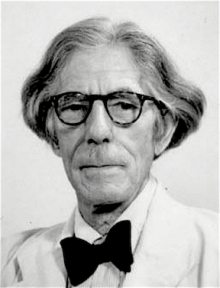
Charles Paget Wade was born at 9 Scotts Lane, Shortlands, near Bromley, Kent, England on 13 February 1883 and was articled to the architect Edward Fernley Bisshopp (1850-1921) in Ipswich, Suffolk from 1900 to 1904. He also attended the Architectural Association Schools in London. He qualified as an architect in 1906 and was elected an Associate of the Royal Institute of British Architects (ARIBA) in 1907.
Between 1907 and 1911 he was employed as an assistant by Raymond Unwin (1863-1940) of Parker & Unwin at Hampstead Garden Suburb. During his time with the practice he designed the tiled arch of Twitten Passage, Asmuns Place, 3 Rotherwick Road, the Great Wall, and the Club House. Aware of his talent as an artist, Unwin commissioned Wade to illustrate his book Town Planning in Practice (1909).
Following the death of his father in 1911, Wade became financially independent. He resigned from Parker & Unwin and subsequently devoted the rest of his life to his own interests, which mainly included illustrating and the collecting of works of art.
In 1914 he produced nearly one hundred illustrations for Bruges: a Record and Impression by Mary Stratton, and in 1915 he drew illustrations for The Spirit of the House by Kate Murray.
Wade exhibited at the Whitechapel Art Gallery in London in 1911 and at the Royal academy in London in 1925. He also participated in the Cotswold Arts and Crafts Exhibition in 1935 and 1936
In 1919 he purchased Snowshill Manor, a dilapidated sixteenth-century Cotswold manor house and spent the next three years restoring tit. Assisted by Mackay Hugh Baillie Scott (1865-1945), he also set about designing a new garden for Snowhill.
Over the next four decades Wade used Snowhill as a repository for his ever-growing eclectic art collection. Wade, himself, didn't live in the building but in the Priest's House, a small cottage beside the manor.
In 1951 Wade gave Snowhill and its collection to the National Trust. From then on he lived on the island of St. Kitts where his family had a sugar estate. He died whilst on a visit to Evesham, Worcestershire, on 28 June 1956.
Aslet, Clive. ‘Snowshill Manor, Gloucestershire’. Country Life vol. 182, no. 50, 15 December 1988 pp. 56-61
Capewell, Paul. Charles Paget Wade before Snowhill. His Early Life and Work at Hampstead Garden Suburb [Place of publication not known]: On the Road Again, 2nd edition, 2019 [ISBN-10 : 1078273529 ISBN-13 : 978-1078273527]
Directory of British Architects 1834-1914. Compiled by Antonia Brodie, et al. Volume 2: L-Z. London; New York: British Architectural Library, Royal Institute of British Architects/Continuum, 2001
Howard, Jonathan. ‘Snowshill Manor: the spirit of the place and the visitor’. Journal of Architectural Conservation vol. 14, no. 1, March 2008 pp. 7-32
Jessup, Michael. Days far away: Memories of Charles Paget Wade 1883-1956. Tewkesbury: National Trust, 1996
Tambling, Kirsten. ‘Small wonders’. [discusses the miniature village Charles Paget Wade created at Snowshill Manor in Gloucestershire] Apollo vol. 196, no. 710, July/August 2022, pp. 60-65.
Venison, Tony. ‘An architect's garden idyll: the gardens of Snowshill Manor, Gloucestershire’. Country Life vol. 163, no. 4219, 18 May 1978 pp. 1358-1360.
Venison, Tony. ‘Arts and Crafts in the garden: Snowshill and the Baillie Scott connection’. Country Life vol. 167, no. 4319, 17 April 1980 pp. 1178-1180
‘Obituary’. RIBA Journal vol. 64, November 1956 p.47
‘Obituary’. The Times 30 June 1956 p.10